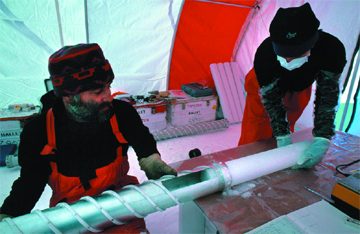 A team
of European researchers released their first round of results from the longest
ice core ever to be recovered from a polar glacier. The new 3-kilometer-thick
core almost doubles the current record from the Vostok ice core in the Antarctic,
which spans 420,000 years. Measurements from the period of ice below Vostok
show some interesting temperature shifts that are likely to cause climatologists
to reevaluate their climate models.
A team
of European researchers released their first round of results from the longest
ice core ever to be recovered from a polar glacier. The new 3-kilometer-thick
core almost doubles the current record from the Vostok ice core in the Antarctic,
which spans 420,000 years. Measurements from the period of ice below Vostok
show some interesting temperature shifts that are likely to cause climatologists
to reevaluate their climate models.Robert Mulvaney and Natalie Holman from the British Antarctic Survey examine the new ice core from Dome C in Vostok. The core almost doubles the climate record previously pulled from the same glacier, with ice layers going back 720,000 years before present. Image courtesy British Antarctic Survey.
Seafloor sediment cores have provided measurements of oxygen-18 isotopes that serve as a proxy for Earth’s climate and ice cover for millions of years. Ice layers, however, record atmospheric conditions and climate much more directly, including temperature and greenhouse gases, such as carbon dioxide and methane. Depending on the amount of snowfall on a glacier, the clarity and thickness of the layers also allows scientists to pull out high-resolution records.
The latest ice record comes from a consortium of scientists taking part in the European Project for Ice Coring in Antarctica (EPICA). They published their initial temperature records from the new East Antarctic core in Nature on June 10. The team showed that the new record matches the previous record to its end, with four or five major interglacial periods that warmed by several degrees Celsius. But the new, deeper layers of ice, covering 420,000 to 740,000 years ago, extend that view. They show that past the 420,000-year mark, glacial and interglacial periods were markedly different than the more recent ones.
“In the last 400,000 years, you’ve got very cold, cold periods and very warm, warm periods,” says Eric Wolff, one of EPICA’s researchers at the British Antarctic Survey. But in the 400,000 years before that, he says, “it never quite reaches warm.” Wolff compares the more recent glacial-to-interglacial warmings to shifting abruptly from winter to summer, whereas the earlier temperature changes are much more subtle, like shifting from spring to fall.
The reason for the difference remains unclear, and Wolff foresees another two to three years of analysis on the lengthy ice core. He says that the next round of data the EPICA team plans to release will be the carbon dioxide record, which will bring even more intense scrutiny.
Research based on the Vostok core has shown that carbon dioxide tends to settle at two levels, Wolff says: 200 parts per million (ppm) during glacial periods and 280 ppm during interglacials. EPICA’s carbon dioxide data will show whether those are “fixed” levels or if the first half of the record, which has more subdued climatic cycles, also has a subdued carbon dioxide increase, he says. The answer will inform the debate over whether carbon dioxide only responds to temperature changes, or if its level is set by the planet’s underlying interactions between the atmosphere and the oceans.
“It’s extremely important to understand which way it goes,” says Jim White of the University of Colorado, Boulder. “We could find that the two [temperature and carbon dioxide] are slavishly tied together,” he says, or that “carbon dioxide is really a driver of the climate system.” Determining whether the Vostok “ceiling and floor” for carbon dioxide levels is systematic is also important, he says, because of the rapid addition of carbon dioxide to the atmosphere since the start of the Industrial Revolution.
Also of interest, White says, is a period known as marine isotope stage 11, which Vostok dipped into but which is completed by the EPICA core. Stage 11 marks a time period when the amount of sunlight the planet received was similar to that of the present-day. The period is also the longest interglacial at 28,000 years and was as warm as the current one (we are now in the middle of stage 1, so far 12,000 years). Now “we have another interglacial period to look at as to whether it’s analogous to our own and hopefully gain some insight into how these interglacials end,” White says. “It would be nice to know if we were headed into an ice age.”

